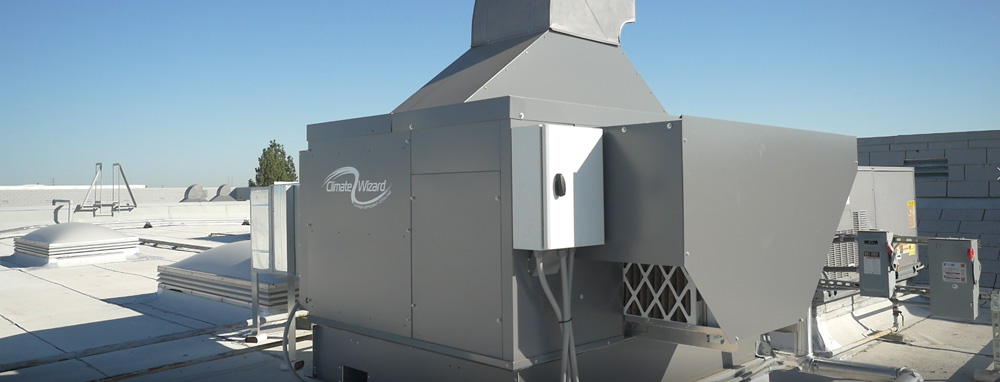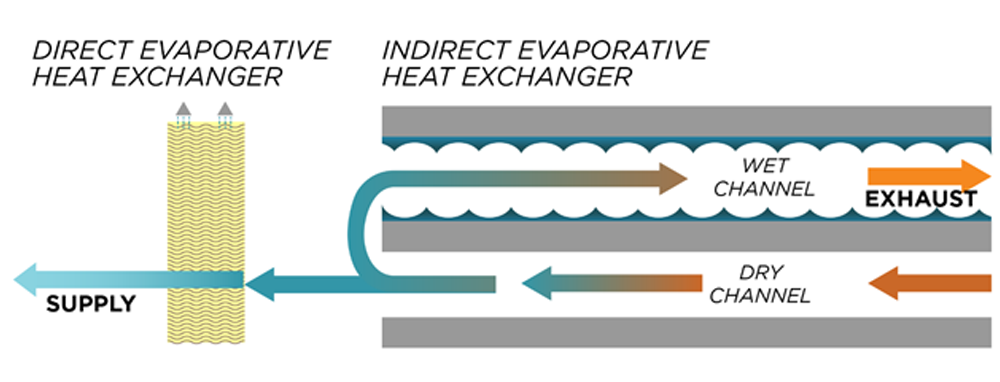
The Seeley Climate Wizard (CW) integrates indirect-direct evaporative cooling to reduce conditioning energy use in residential and commercial buildings. The residential system (CW3) relies strictly on evaporative processes to provide cooling while the commercial system (CW Hybrid) integrates a heat pump to provide both space heating and cooling. The systems integrate indirect and direct cooling in series by passing the air through an indirect-evaporative heat exchanger followed by direct-evaporative media. The hot dry outdoor air is first cooled indirectly with cool moist air through a heat exchanger. Once precooled, a portion of the cooled outdoor air is diverted to the wet channels of the heat exchanger to cool incoming outdoor air while the other portion is sent through the direct evaporative media where it is cooled further before getting delivered to the home (Figure 1).

Figure 1: Diagram of the Indirect-Direct Cooling Process Implemented in the CW3
This indirect-direct cooling module provides cooling very efficiently using only two sets of fans and water pumps. Relying on evaporative cooling eliminates the need for refrigerants, which typically have high global warming potential, and the associated compressor which consumes much of the electricity used by a traditional air conditioner. This reduction in energy consumption, due to the elimination of the standard vapor-compression equipment, allows the system to achieve much higher efficiencies in many California climate conditions compared to traditional cooling systems.
In the state of California, reducing peak demand has become a key method for lowering total greenhouse gas emissions. As part of reducing peak demand, alternatives such as evaporative cooling methods should be considered as a replacement for traditional direct expansion technologies due to their comparatively lower energy consumption. The one limitation of evaporative cooling technologies is that their performance is highly dependent on the outdoor air conditions, specifically humidity levels. These technologies are particularly well suited for California because of its hot dry climate during the summer when peak demand is at its highest.
Previous Work
WCEC has performed multiple projects related to the CW products, including laboratory testing, modeling energy use, and field testing. Researchers tested the residential CW3 product in the laboratory to develop a detailed performance map of system performance across a wide range of climate conditions. That performance map was used to create an EnergyPlus model to simulate performance of the CW3 system in a single-family prototype building relative to a baseline system in each California climate zone. Another project is looking at the CW Hybrid system installed at a California school and comparing the performance to the standard equipment on an identical classroom. These projects have also contributed to the codes and standards development process in California by providing necessary data for incorporating indirect evaporative cooling products in the compliance modeling software.
WCEC has worked with a number of different indirect-direct evaporative cooling products over the years, including field testing of the Coolerado H80 hybrid air conditioner with integrated gas heating, as well as field testing of direct outdoor air systems developed by Munters, Coolerado, and Seeley that incorporate indirect-direct evaporative cooling to serve the ventilation for commercial buildings. Coolerado was ultimately purchased by Seeley and that collaboration has resulted in the development of the latest CW products.
RESOURCES
PUBLICATIONS
- Packaged Roof Top Unit with Integrated Heat Pump and Indirect/Direct Evaporative Cooling (Technical Report, 2022)
- Performance Evaluation of a Residential Indirect-Direct Evaporative Cooler (IDEC) (Project Report, 2020)
- Indirect Evaporative Air Conditioning for a Restaurant (Project Report, 2015)
- Climate Appropriate Cooling for a Grocery Store: Hybrid Unitary DOAS System (Project Report, 2015)
- Coolerado H80 Rooftop Unit Field Test (Case Study, 2013)
- Coolerado H80 Field Report (Project Report, 2013)
ADDITIONAL RESOURCES
Sponsor: PG&E, SDG&E, CEC
Collaborators: Seeley
